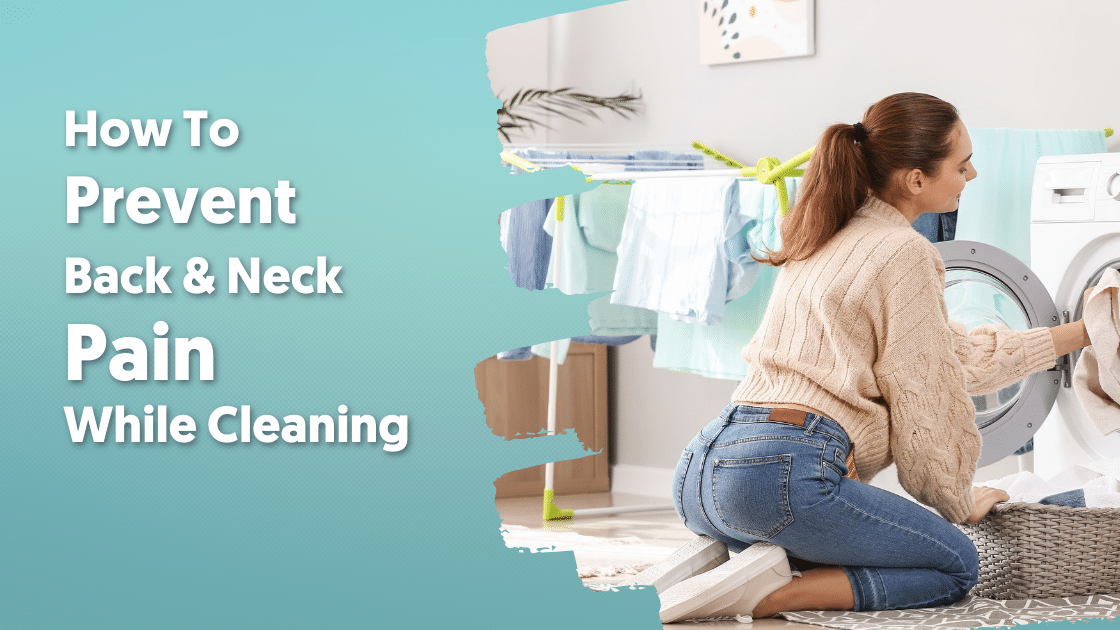With the holiday season quickly approaching, it’s the perfect time to do a thorough deep cleaning. It allows you to disinfect, declutter and get rid of any dust and dirt that may have collected throughout the past few months. Unfortunately, we often don’t pay much attention to our posture as we do the dishes, clean the windows, or vacuum the carpet. Here are some helpful tips on how to prevent back and neck pain while cleaning.
Vacuuming
Vacuuming is one of the most notorious culprits for causing back and neck pain. It’s a chore that can quickly cause your lower back to habitually bend forward and lead to intervertebral disc problems.
To protect your back, stand up tall while holding the vacuum in front of you. Instead of extending your arms forward to push the vacuum back and forth, keep your elbows in a locked position close to your body and walk with the vacuum.
To vacuum underneath furniture, simply kneel down in a stable position and use the hose attachments. Try breaking your vacuuming up into smaller sections or by room so you don’t overexert yourself. You’re far more likely to begin slouching the more fatigued you become.
Laundry

When it comes to laundry, maintaining proper posture is key to preventing back and neck pain. For top-loading washers and dryers, stand directly in front of the machine and bend at the hips if needed. Bending at your hip protects your back by allowing it to stay straight, whereas bending at your waist will cause your back to round and lead to back and neck pain.
For front-loading washers and dryers, kneel down or use a firm, stable chair to sit on while loading and unloading your clothes. Avoid over-extending and aggressive twisting motions, as these movements can be risky and even throw off your balance.
Break the loads into smaller, lighter weighing piles so they are easier to manage and won’t put excessive force on your back or neck. It’s important to place your laundry basket on a chair or table, preferably the same height as the laundry machines, to minimize the amount of bending and reaching.
Doing The Dishes
In an ideal world, you would be able to do the dishes without having to bend over or reach down. Unfortunately, sink heights are not one-size-fits-all. As with doing laundry, you will want to do your dish cleaning between the height of your waist and shoulders.
If you are unable to reach the sink without bending over, use a sturdy step stool to raise yourself up. Likewise, you can raise the height of your workspace to waist level. Simply take two plastic tubs and place one upside down in the sink and the other on top of it. Not only will you avoid reaching down to the bottom of the sink, but you’ll be able to do all of your washing at a much more comfortable height.
As previously mentioned, bending at your hip allows you to keep your back straight. This hip hinge movement is extremely important to use when it comes to loading and unloading dishes from the dishwasher. Make sure to bend your knees as you’re moving your hips back so you utilize the larger muscles in your legs to move your body rather than relying on your low back muscles.
Window Cleaning
Keeping your house clean is a lot of work and cleaning your windows is no exception. Most windows are quite lengthy or have a furniture-filled obstacle course in their way and require you to be in compromising positions just to reach them. This can be strenuous on your back and neck, and can even cause strain or injury.
To protect your back, neck, and shoulders, it’s important to avoid working too high above your head. Instead of stretching out to reach more area, make several small, short movements. Take your time and keep your stomach muscles tight and your back straight. To clean high, hard-to-reach places, use a small step stool to raise your entire body closer to your destination.
Whether you’re mopping the floor or dusting off bookshelves, it’s vital to practice proper body mechanics. Keep these tips in mind the next time you’re cleaning around the house to help prevent back and neck pain.



